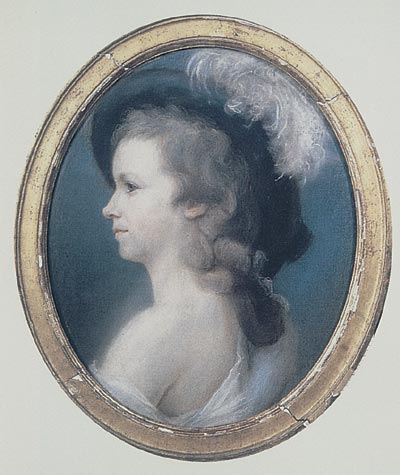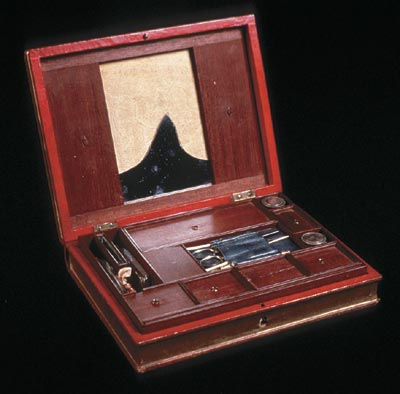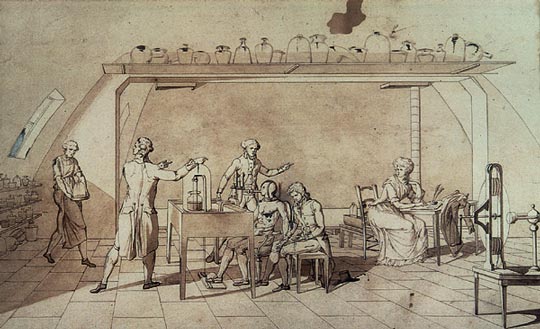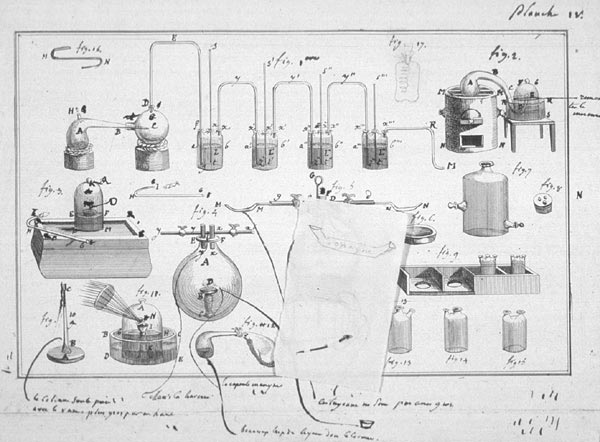Mme. Lavoisier
By Roald Hoffmann
The scientific and artistic life of the famous chemist's wife
The scientific and artistic life of the famous chemist's wife

DOI: 10.1511/2002.13.22
In 1771 Marie Anne Pierrette Paulze was a lively girl of 13. When her mother passed away, the young woman left a convent school to help her father as a hostess. Her vivacity attracted a friend of the family, the 50-year-old Count d'Amerval. A remarkable letter survives in Cornell's Lavoisier collection in which Marie Anne's father diplomatically yet directly declines the Count's proposal.

Private collection
Another suitor was much more welcome. Antoine Laurent Lavoisier had a law degree, but his passion was for science. As a young man, he impressed the French scientific establishment with his geological and chemical research. Lavoisier had just bought a half share in the Ferme Générale—the ancien régime's version of what the Internal Revenue Service might be heading for in some conservative dream—a private company collecting taxes for the crown. Marie Anne's father was one of the leading "Farmers."
Lavoisier was a frequent visitor at the Paulze house. He and Marie Anne played romantic board games, but also spoke of geology, chemistry and astronomy. When the father proposed a marriage, both young people welcomed it. Antoine was 28, Marie Anne 13 when they married. A lovely self-portrait of Mme. Lavoisier survives, which she must have painted not long after.
In telling the story of Mme. Lavoisier, I will not do justice (in several ways) to her husband. This young natural philosopher mastered the art of careful experimentation in chemistry and physics. Independently wealthy from his fermier's income, he filled a private laboratory with balances, burning lenses and metal vessels of an unmatched magnitude and quality. In a way, Lavoisier's science was the big science of his day. His feeling for balance found expression in science: "Nothing is gained, nothing is lost" could be applied equally to economics and to the mass balances of chemistry.

Photograph by Charles Harrison, courtesy of the Cornell University Library
Lavoisier gave the first correct accounts of burning, respiration and rusting. In bringing about the Chemical Revolution, he properly defined the elements (though he thought heat was one), showed that water was a compound and air a mixture, and proposed a new systematic nomenclature for chemistry. In the remainder of his time, he dealt with one practical problem after another—he debunked mesmerism, thought about contagious disease in cities, ensured that young America got its gunpowder, adjudicated disputes on ballooning and, after the revolution, participated in the work on the metric system. Citizen Lavoisier's work for the French Republic did not save him from the Jacobin terror. On May 8, 1794, he and his father-in-law were executed, along with 26 other Farmers General.
Mme. Lavoisier ran a popular salon, to be sure. But from early on in her marriage she took instruction in chemistry to help her husband in his work. She learned to read English to translate important books from a language Lavoisier lacked. Mme. Lavoisier learned to draw from Jacques-Louis David. His expensively commissioned portrait of the couple (published in American Scientist, January–February 1996) tells us of their relationship. The two are physically close, her arm rests on his shoulder. But there is a distance between them. To me there is also a certain tension in the leaning posture of Mme. Lavoisier—am I imagining that she is pressing in, and would like to enter Lavoisier's realm of instruments in the right-hand part of the picture? Lavoisier looks at his wife—she looks out as us, at the world. They had no children.

Private collection
After her husband's death, Mme. Lavoisier herself spent 65 days in jail. Emerging, she recovered his confiscated books and kept his works in print. Long loved by Pierre Samuel Dupont de Nemours, she rejected him. In 1805 she married the American/ British/Bavarian adventurer, inventor and scientist Benjamin Thompson, Count Rumford. The marriage was an unhappy one—it's reported that she poured boiling water on his flowers—and ended four years later. Mme. Lavoisier lived on until 1836.
There is no biography of Mme. Lavoisier. I think she deserves an opera.
There is no published scientific paper in Marie Anne Lavoisier's name. She translated from the English Kirwan's "An Essay on Phlogiston," with appended notes by Lavoisier and friends, notes intended (correctly) to systematically demolish Kirwan's argument. The original edition did not carry her name as translator, but subsequent ones did.

Reproduced courtesy of the Cornell University Library
Elsewhere, she draws herself in their laboratory. Two of her strikingly realistic and beautifully composed images of Lavoisier's work on respiration survive. These are classic visual documents of chemical experimentation. In Figure 3, Mme. Lavoisier is at right, sitting at a table, quill in hand. She turns to observe the experiment, waiting to write down the measurements as they are called out by her husband or his assistant. Here she is an amanuensis. She was more at times; she also wrote the plan for what experiments were done at Lavoisier's Arsenal laboratory on a particular day.
And Marie Anne Lavoisier produced the plates for Lavoisier's Traité Élémentaire de Chimie, published in the year 1789, that of another Revolution. In Cornell's library are her watercolor sketches for the 13 remarkable plates that illustrated the book that changed chemistry. We have several êtats of the plates, including the one shown here (Figure 4), where she adds a correction in the 1789 equivalent of a Post-It, a paper note literally pinned to the print. We have a copper plate, which she engraved herself; the plates from beginning to end are Mme. Lavoisier's work. When satisfied, she signed a proof Bonne, followed by her initials. In the book there is no credit to her, only the plates are signed Paulze Lavoisier sculpsit, to testify to her engraving.
Mme. Lavoisier could not have been a chemist. No fault of her own, for she had the intelligence and the training—society did not allow women to follow that path for a hundred years after her time. That's how long France had to wait for another Marie.
There were exceptions, for in many ways 18th- century French culture did provide a place for women as intellectuals, more so than other European societies of the time. Forty years before Mme. Lavoisier, there was Emilie de Breteuil, the Marquise du Châtelet (1706–1749), who studied mathematics and physics. She married, in the normal way of aristocracy, and led an intellectual life separate from her marriage. Voltaire, her lover for some years, encouraged her to undertake the first full French translation of Newton's Principia. This she did, ably so, and also wrote of Leibniz's work. A younger contemporary of Mme. Lavoisier was the mathematician Sophie Germain (1776–1831), who used a pseudonym to come into professional contact with J. L. Lagrange and Carl Friedrich Gauss.
The exceptions were just that; the world of the Salons—an exciting intellectual world to be sure—and a correspondence with natural philosophers is what upper class women could aspire to. At best. I speculate that Mme. Lavoisier was not resentful; she shifted her creativity into other channels, as many a woman has done over millennia.
Still, when I think of the story of Mme. Lavoisier, I feel a great loss, a sadness. This smart woman was much less isolated from the scientific world than Mme. du Châtelet. As her drawings and the historical record testify, Mme. Lavoisier moved in the company of scientists, and good ones at that. The sadness that comes over me is that they, and her husband in the first line, did not recognize her abilities. David Corson has shown me, and not once, that intimate treasure trove of Cornell's Lavoisier Collection. I thank Marco Beretta for allowing me to use some of the illustrations he so lovingly has collected and analyzed, and Pierre Laszlo for a corrective comment.
© Roald Hoffmann
Click "American Scientist" to access home page
American Scientist Comments and Discussion
To discuss our articles or comment on them, please share them and tag American Scientist on social media platforms. Here are links to our profiles on Twitter, Facebook, and LinkedIn.
If we re-share your post, we will moderate comments/discussion following our comments policy.